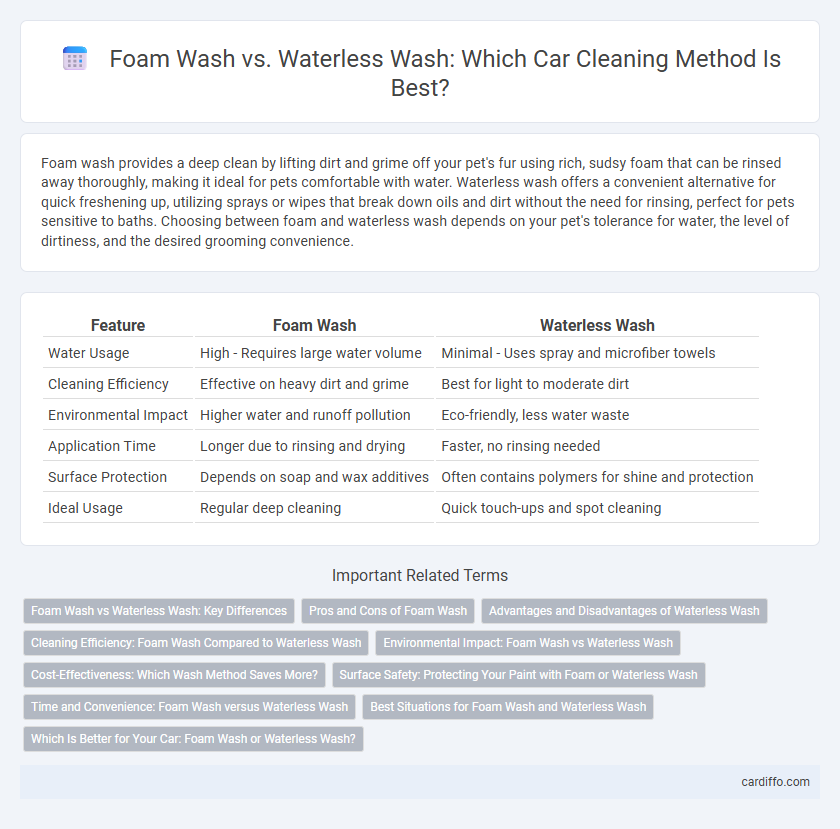Foam wash provides a deep clean by lifting dirt and grime off your pet's fur using rich, sudsy foam that can be rinsed away thoroughly, making it ideal for pets comfortable with water. Waterless wash offers a convenient alternative for quick freshening up, utilizing sprays or wipes that break down oils and dirt without the need for rinsing, perfect for pets sensitive to baths. Choosing between foam and waterless wash depends on your pet's tolerance for water, the level of dirtiness, and the desired grooming convenience.
Table of Comparison
| Feature | Foam Wash | Waterless Wash |
|---|---|---|
| Water Usage | High - Requires large water volume | Minimal - Uses spray and microfiber towels |
| Cleaning Efficiency | Effective on heavy dirt and grime | Best for light to moderate dirt |
| Environmental Impact | Higher water and runoff pollution | Eco-friendly, less water waste |
| Application Time | Longer due to rinsing and drying | Faster, no rinsing needed |
| Surface Protection | Depends on soap and wax additives | Often contains polymers for shine and protection |
| Ideal Usage | Regular deep cleaning | Quick touch-ups and spot cleaning |
Foam Wash vs Waterless Wash: Key Differences
Foam wash uses a thick layer of foam to lift dirt and grime from vehicle surfaces, requiring water for rinsing, which ensures thorough removal of contaminants. Waterless wash, on the other hand, relies on specialized solvents and lubricants to encapsulate dirt particles, allowing cleaning without the need for water or rinsing. Foam wash is ideal for heavily soiled vehicles, while waterless wash offers convenience and environmental benefits for lightly dirty surfaces or quick touch-ups.
Pros and Cons of Foam Wash
Foam wash provides deep cleaning by lifting dirt and grime effectively without scratching the vehicle's surface, making it ideal for thorough car care. It requires a water source, which can be a limitation in areas with water restrictions or during droughts. The foam wash process can be time-consuming and may require additional rinsing, increasing water usage compared to waterless wash options.
Advantages and Disadvantages of Waterless Wash
Waterless wash offers the advantage of conserving water, making it an eco-friendly choice especially in drought-prone areas. It requires less time and effort compared to foam wash, as it eliminates the need for rinsing and drying. However, waterless wash may not effectively remove heavy dirt or stubborn stains, posing a limitation for extremely dirty vehicles.
Cleaning Efficiency: Foam Wash Compared to Waterless Wash
Foam wash delivers superior cleaning efficiency by encapsulating dirt and grime in dense bubbles, allowing for more effective loosening and removal compared to waterless wash. The higher moisture content in foam wash aids in preventing abrasion on vehicle surfaces, reducing the risk of scratches during cleaning. Waterless wash, while convenient, often requires more effort and stronger chemical agents to break down contaminants, which can compromise cleaning results and surface protection.
Environmental Impact: Foam Wash vs Waterless Wash
Foam wash uses significantly less water compared to traditional washing methods, reducing runoff and water waste, while waterless wash formulas minimize water consumption entirely by relying on biodegradable cleaning agents. Both techniques limit harmful chemical discharge, but waterless washes typically contain concentrated, eco-friendly compounds that break down quicker in the environment. Choosing between foam wash and waterless wash hinges on balancing water savings with the specific environmental safety of detergents and additives used.
Cost-Effectiveness: Which Wash Method Saves More?
Foam wash typically requires less water and detergent, reducing overall consumption and lowering utility bills compared to traditional water-heavy methods. Waterless wash products, though offering convenience and eliminating water use entirely, often come at a higher cost per application due to specialized chemicals. Evaluating cost-effectiveness depends on usage frequency and resource availability, with foam wash generally saving more in long-term expenses for regular vehicle maintenance.
Surface Safety: Protecting Your Paint with Foam or Waterless Wash
Foam wash provides a thick layer of suds that encapsulates dirt and debris, reducing the risk of scratches on your vehicle's paint by gently lifting contaminants before rinsing. Waterless wash uses advanced lubricants and cleaning agents to safely dissolve dirt without the need for water, minimizing surface abrasion especially on lightly soiled vehicles. Both methods prioritize surface safety, but foam wash offers superior protection for heavily soiled surfaces by thoroughly loosening grime while maintaining paint integrity.
Time and Convenience: Foam Wash versus Waterless Wash
Foam Wash reduces cleaning time by loosening dirt and grime quickly, making rinsing efficient and fast, which saves significant effort compared to traditional washing methods. Waterless Wash offers convenience by eliminating the need for water, enabling vehicle cleaning anywhere without a hose or bucket, ideal for quick touch-ups. Both methods enhance time efficiency, but Foam Wash suits more thorough cleaning while Waterless Wash excels in portability and speed for spot cleaning.
Best Situations for Foam Wash and Waterless Wash
Foam wash excels in situations where vehicles are heavily soiled with dirt, mud, or road grime, as its thick lather effectively loosens and encapsulates debris for easy removal. Waterless wash is ideal for lightly soiled vehicles or quick touch-ups, offering a convenient solution that conserves water while minimizing surface scratches. Choosing foam wash or waterless wash depends on vehicle condition, environmental considerations, and available resources.
Which Is Better for Your Car: Foam Wash or Waterless Wash?
Foam wash effectively removes dirt and grime with thick suds that lift debris from your car's surface, minimizing scratches and providing a deep clean ideal for heavily soiled vehicles. Waterless wash uses advanced cleaning agents and lubricants to safely dissolve and wipe away contaminants without water, making it perfect for quick maintenance and eco-friendly car care. Choosing between foam wash and waterless wash depends on your car's cleanliness level, environmental concerns, and convenience needs.
Foam Wash vs Waterless Wash Infographic

 cardiffo.com
cardiffo.com